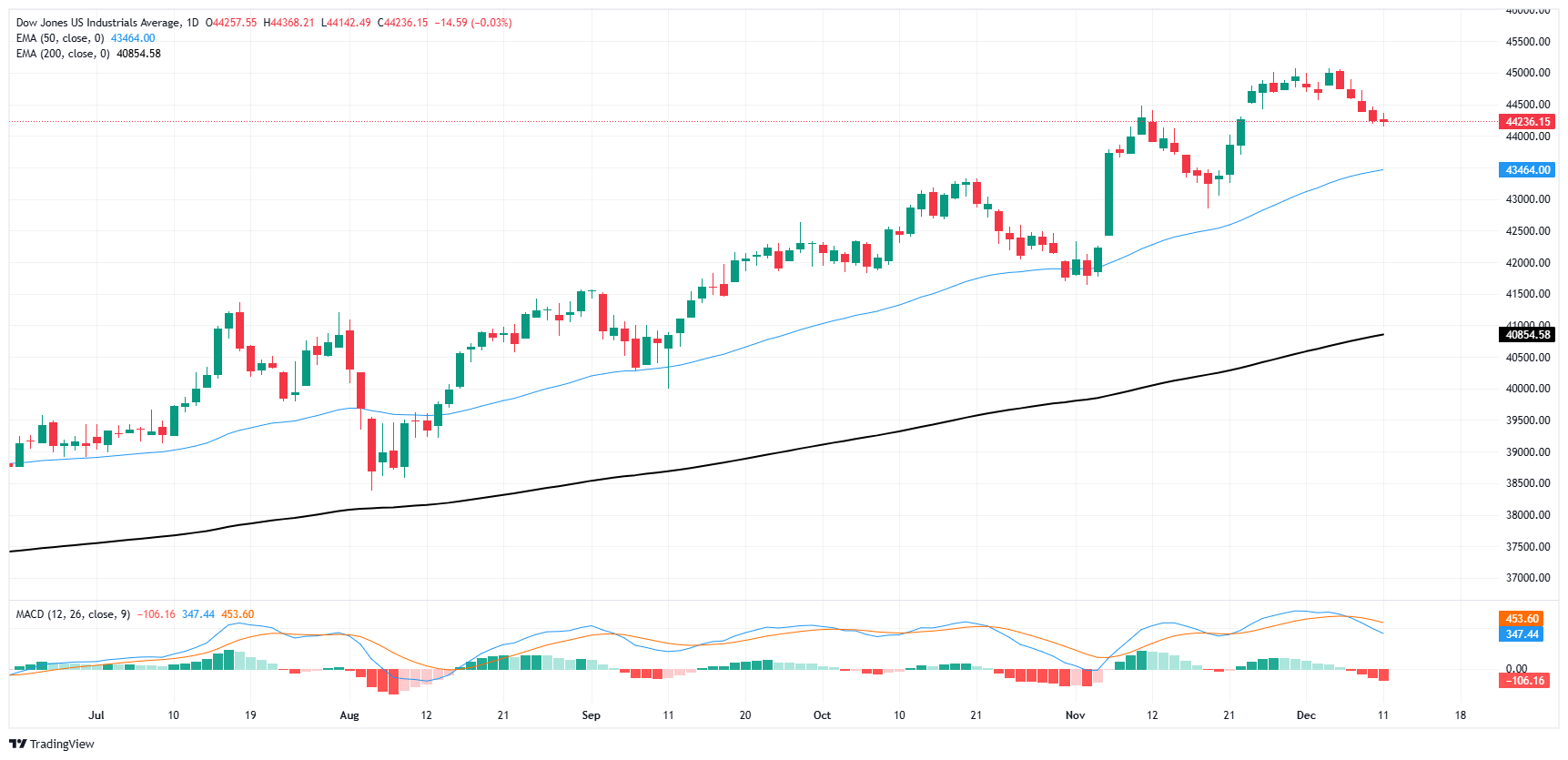Dow Jones Industrial Average treads water after US CPI meets expectations
- The Dow Jones spun in a tight circle on Wednesday near 44,200.
- Market expectations for US CPI inflation were met, keeping rate cut hopes on-balance.
- The tech sector rose on Wednesday, offsetting declines in health services.
The Dow Jones Industrial Average (DJIA) spun in a tight circle on Wednesday, keeping close tabs on the 44,200 level after US Consumer Price Index (CPI) inflation broadly met market expectations. Despite an uptick in annualized CPI inflation figures, investors remained confident that the Federal Reserve is on pace to deliver one last quarter-point rate cut before the end of the year.
US CPI inflation rose slightly for the year ended in November, with headline CPI inflation ticking up to 2.7% YoY from 2.6%, while core CPI inflation held steady at 3.3% YoY. Monthly headline CPI inflation also rose in November, climbing to 0.3% MoM from October’s 0.2%. Despite the overall upswing in main inflation figures, Wednesday’s CPI print was broadly in line with forecasts, keeping investor sentiment tepid.
According to the CME’s FedWatch Tool, rate traders are now pricing in 95% odds of a 25 bps rate cut when the Federal Reserve (Fed) convenes for its last rate call on December 18. Despite the near-term uptick in CPI inflation, investors have decided that the wiggle in reported figures isn’t enough to push the Fed away from delivering one last quarter-point cut to wrap up 2024.
Dow Jones news
The Dow Jones struck a middling note on Wednesday, with gains in tech and communications stocks getting weighed down by losses in health services. Nvidia (NVDA) rose over 3.3% to test $130 per share as the AI rally continues on the back of rate cut expectations, while Unitedhealth Group shed nearly 5% to fall below $540 per share in the wake of the assassination of a Unitedhealth C-suite executive last week.
Dow Jones price forecast
The Dow Jones is holding steady on the low end of a recent downturn. The major equity index peaked just above the 45,000 major handle just last week, and bullish momentum is taking a rare breather and allowing price action to return to some version of normalcy. The index is down 1.8% from all-time highs and treading water just north of 44,000.
Despite a near-term pullback, the Dow Jones is poised for another leg higher if short momentum is able to drag bids back down to the 50-day Exponential Moving Average (EMA) near 43,460. The long-term trend still favors bidders however, with the DJIA still up a stellar 17% and change YTD in 2024.
Dow Jones daily chart
Dow Jones FAQs
The Dow Jones Industrial Average, one of the oldest stock market indices in the world, is compiled of the 30 most traded stocks in the US. The index is price-weighted rather than weighted by capitalization. It is calculated by summing the prices of the constituent stocks and dividing them by a factor, currently 0.152. The index was founded by Charles Dow, who also founded the Wall Street Journal. In later years it has been criticized for not being broadly representative enough because it only tracks 30 conglomerates, unlike broader indices such as the S&P 500.
Many different factors drive the Dow Jones Industrial Average (DJIA). The aggregate performance of the component companies revealed in quarterly company earnings reports is the main one. US and global macroeconomic data also contributes as it impacts on investor sentiment. The level of interest rates, set by the Federal Reserve (Fed), also influences the DJIA as it affects the cost of credit, on which many corporations are heavily reliant. Therefore, inflation can be a major driver as well as other metrics which impact the Fed decisions.
Dow Theory is a method for identifying the primary trend of the stock market developed by Charles Dow. A key step is to compare the direction of the Dow Jones Industrial Average (DJIA) and the Dow Jones Transportation Average (DJTA) and only follow trends where both are moving in the same direction. Volume is a confirmatory criteria. The theory uses elements of peak and trough analysis. Dow’s theory posits three trend phases: accumulation, when smart money starts buying or selling; public participation, when the wider public joins in; and distribution, when the smart money exits.
There are a number of ways to trade the DJIA. One is to use ETFs which allow investors to trade the DJIA as a single security, rather than having to buy shares in all 30 constituent companies. A leading example is the SPDR Dow Jones Industrial Average ETF (DIA). DJIA futures contracts enable traders to speculate on the future value of the index and Options provide the right, but not the obligation, to buy or sell the index at a predetermined price in the future. Mutual funds enable investors to buy a share of a diversified portfolio of DJIA stocks thus providing exposure to the overall index.


